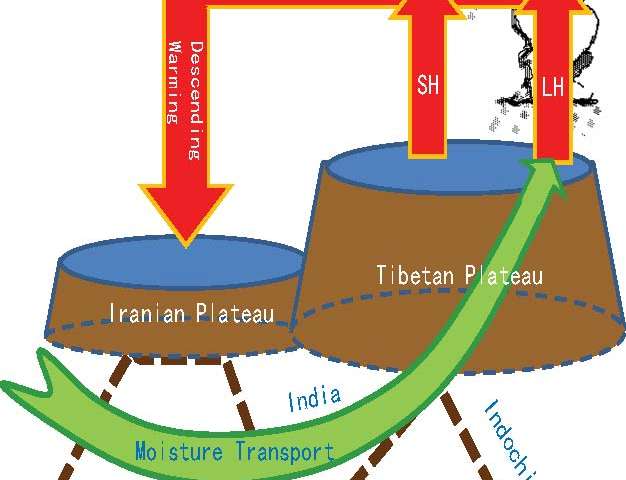Mechanism of the influence of the Tibetan-Iranian Plateaus on the circulation and climate in summer

The highest and largest plateau in the Northern Hemisphere, the Tibetan Plateau (TP), is in the subtropical region of Asia. The air pressure above the TP is only 60 percent of the sea level. In addition, because the radiation over the plateau, especially in the boundary layer, is significantly different from that of the low altitude region, the thermal process over the TP has obvious particularity. Through its special thermodynamic and dynamic effects, the TP and its adjacent Iran Plateau (IP) have significant impacts on the circulation and climate over the plateaus as well as the adjacent region and the globe. However, the heat source interaction, circulation and feedback between the TP and IP is not clear.
Professors Wu Guoxiong and Liu Yimin and their students from the Institute of Atmospheric Physics, Chinese Academy of Sciences, conducted a recent study making progress on this issue. With theoretical diagnostic analysis and simulations by regional model, the researchers have revealed the physical process of interaction and feedback between the two types of summertime heating: the surface sensible heating and condensation heating over the TP; and the surface sensible heating over the Tibetan-Iranian Plateaus. They also discovered how this interaction affects the vertical thermodynamic structure near the tropopause over Asia.
The maintenance of a steady state in the atmosphere is only possible by obtaining external energies, particularly through the transfer of surface sensible heating. This study showed that the TP surface sensible heating can generate convective precipitation over the southern and eastern TP, whereas the precipitation over the TP can reduce the in situ surface sensible heating. This indicates the existence of a feedback or interaction process between the two types of diabatic heating over the TP. Furthermore they documented that the surface sensible heating over the two plateaus not only has mutual influences, but also feedback between each other. The IP surface sensible heating can reduce the surface sensible heating and increase the condensation heating over the TP, whereas the TP surface sensible heating can increase IP sensible heating, thereby reaching quasi-equilibrium of surface sensible heating and condensation heating over the TP, the IP surface sensible heating and the atmospheric vertical motion. Therefore, a so-called Tibetan-Iranian Plateau coupling system (TIPS) is constructed, which influences atmosphere circulation (Figure).
"The interaction between surface sensible heating and latent heating over the TP plays a leading role in the TIPS," said Prof. Wu. The influences of surface sensible heating of the IP and TP on other regions not only have superimposed effects, but are also mutually offset. The combined influence over TP and IP represents the major contribution to the convergence of water vapor transport in the Asian subtropical monsoon region. In addition, the heating of TIPS increases the upper tropospheric temperature maximum and lifts the tropopause, cooling the lower stratosphere. Combined with large-scale thermal forcing of the Eurasian continent, the TIPS produces a strong anticyclonic circulation and the South Asian High that warms the upper troposphere and cools the lower stratosphere, thereby affecting regional and global weather and climate.
The results improve the understanding of the climate dynamics of the TP. It will also contribute to better regional weather and climate prediction.
More information:
YiMin Liu et al, Two types of summertime heating over Asian large-scale orography and excitation of potential-vorticity forcing II. Sensible heating over Tibetan-Iranian Plateau, Science China Earth Sciences (2017). DOI: 10.1007/s11430-016-9016-3
Provided by Science China Press